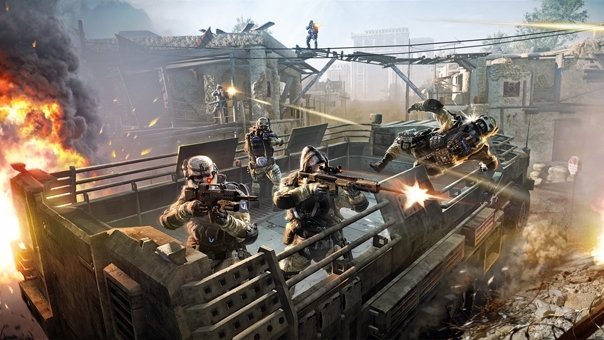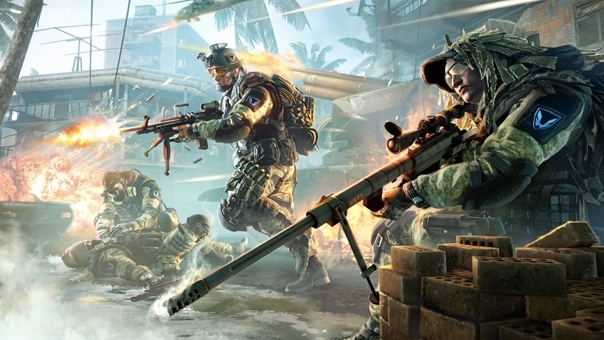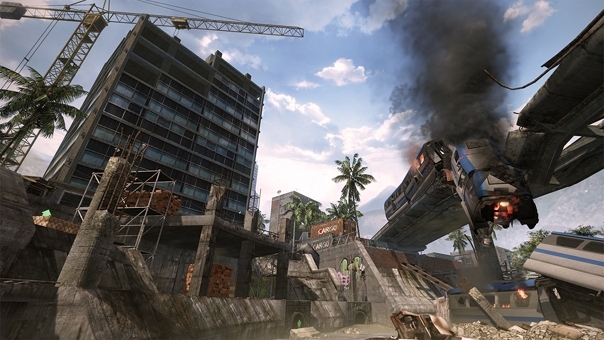Warface: Shooting for Answers
We take a first look at Crytek's free-to-play shooter, with the help of producer Peter Holzapfel.

When I first heard about Warface, I was surprised. Crytek , the developer behind such legendary shooters as Crysis and Far Cry, was entering the free-to-play arena. To my uneducated eyes the process was simple: produce some incredible games, sell a staggering number of copies, rinse and repeat. But as producer Peter Holzapfel described at the recent Eurogamer Expo, the gaming landscape is changing.
On the surface, Warface is a superbly executed first-person shooter, as you’d expect from a developer with a pedigree like Crytek’s. For the 100-strong team at the developer’s Kiev studio, the game represents something more; an opportunity to find out how free-to-play actually works in the myriad of markets throughout the globe. In creating a lightweight, accessible, team based shooter, the team has built a laboratory of carnage with which to experiment.
It’s an experiment that already seems to be paying off, with Warface launched in some territories. When I asked Holzapfel about how it had performed in Russia, he grinned at me before replying. “What would be the correct adjective… mind-blowingly successful so far?” By partnering with Trion in Western markets, Crytek hopes to repeat that success when beta starts later this year.
Free-to-Play First Steps
The idea for building Warface as a free-to-play game came from Asian markets, as Holzapfel explained. “Seeing what happened there, as in the number of players that are actually loving this kind of model, was just impressive.” He added that the growing number of high-quality free-to-play games was also encouraging.
This is about more than the changing face of online gaming, with Warface representing a shift in approach for the German developer. "We truly believe that the free to play model is something that’s, pretty much from our perspective, the fairest model for developers and gamers at the same time, if you get it right.” Holzapfel is also confident that gamers will stick around if he treats them seriously. “If you do a good game, players will stay with you, and they will get more and more into you, because you’re handing them a great product for free.”
Set in a near future where global governments have collapsed, Warface hires you as an elite freedom-fighter against a megalomaniacal organization known as Blackwood. This mercenaries-versus-megacorporation conflict provides the backdrop for a variety of locations, from gritty urban jungle to isolated mountain village, all beautifully rendered using CryEngine 3. But, while these regions play host to some classic team-based PVP, there’s also a refreshingly different co-op mode to haul your friends into.
War has many faces, with Warface offering four of them at present. The Rifleman and Sniper classes are focused purely on firepower, while the Medic and Engineer provide crucial squad support. Whichever pair of boots you decide to wear, there’s also a range of weapons and gear available to unlock. Once an item is unlocked it becomes available for all classes, encouraging experimentation. “We don’t want players to get attached to a single class, going through the whole progression thing and then not wanting to start a different class, but actually encourage jumping between the different classes and finding out all the different play styles for them.”
Alongside the progression system will be a marketplace, although the details are still being fleshed out by the localization team. Their goal is to have every piece of equipment available to purchase with either in-game currency or real money, together with a range of convenience items such as experience boosters and bundles. Frugal gamers can completely avoid spending hard cash, either by patiently saving for a particular item, or by playing well and earning masses of experience.

The Social Shooter
Despite having tutorial missions and single-player campaigns, team-based PVP shooters have struggled with training newcomers. Having both the time and the resilience to push through that initial learning phase is becoming tougher. “When I was 18, just starting university, I had a lot of time where I could play games for hours and hours. Now I don’t have that time anymore, and it can be quite frustrating. Arriving late to a game, everybody knows the maps inside out, you get shot in the face every five minutes, and you start again, this sort of thing.”
It’s one of the reasons why Crytek decided to add a PvE mode to Warface, where teams of five players can battle it out against AI opponents in a mission that changes daily. “We really wanted to create this access point with co-op, where people get to know the game, know how to handle the weapons, know how to do all the special moves, really work together as a team. And then, if they want to and feel comfortable, move over to PvP.”
For Holzapfel, it’s all about breaking down those barriers to getting in the game. “We really wanted to keep the product as accessible as possible, and that’s one of our major claims for the game. In each and every area, when it comes to hardware requirement, distribution model, business model, and when it comes to design choices like co-op.” In territories where Warface has already launched, players tend to dive into the daily mission, try out the double-XP hard mode version, then play PvP for the rest of the evening.
In order to create a method for players to team up and tackle the daily missions, Crytek realized that they needed to build some form of social glue that would work outside the game. Currently in closed beta, GFACE is their result – a browser-based gaming network. It also provides the foundation for a community, which Holzapfel hopes will work with them in improving Warface further. “It’s one of the cool things about this model that we have the freedom to say, even when we come out with the game, there’s still stuff we probably haven’t thought about.”

Through Beta and Beyond
Crytek isn’t planning to fire and forget Warface, slapping on an English translation and calling it a day. Instead, Holzapfel plans to use a mix of game designers, player feedback and analytics to carry the game through beta and beyond. “I think purely designing around user feedback and analysis is tricky, as well as purely designing on gut feeling and experience. One has to influence the other; one has to validate the choices that you make, and so on.”
As a result, every move we make in Warface will feed that massive data machine. One output is a collection of heatmaps that help to isolate flaws in zones that players shouldn’t be able to reach. “They come up with the craziest and weirdest ideas to get to certain spots, and figuring that out is very helpful.” Holzapfel also added that, while feedback on existing features is great, he’s also excited about new ideas the community comes up with. During a developer presentation at Eurogamer Expo, he even hinted that the team might start accepting player-created maps and mods in the future. The CryEngine 3 SDK, on which Warface is build, is available as a free download if you want to get your dev hands dirty.
It’s also why localizing Warface is more than a translation effort, with gaming cultures having different opinions on how free-to-play should work. “For us, being based in Frankfurt, we focused on Western territories so far. It’s really hard to know what is OK for a Chinese player.” Crytek’s solution was to set up local co-production teams to support a deep level of localization. “In Eastern territories, at least right now, it’s totally acceptable to rent weapons for a period of time. Our research right now shows that, for Western territories, we would need to take a different approach.”
For Western markets such as USA and Europe, Crytek decided to partner and co-publish with Trion, with the RIFT developer lending its technical, community management and customer support expertise. “So far, our experience working with Trion has been really positive. It really feels like they understand developers and what development is about. As Crytek we have a special standing anyhow, because we’re a very strong developer, but the partnership we’ve experienced with Trion so far has been very positive.” Does co-publishing with several partners globally keep Holzapfel and his team on their toes? “Definitely! It questions everything you know. ‘This is what good design is about, and we know it because we’ve done it for a long time.’ But, actually, sometimes it’s not.”
Warface is due to enter closed beta later this year, with full launch slated for some time in 2013. Those wanting to get involved in Crytek’ free-to-play firefights as early as possible should head over to the signup page now!
Gareth “Gazimoff” Harmer, Staff Writer